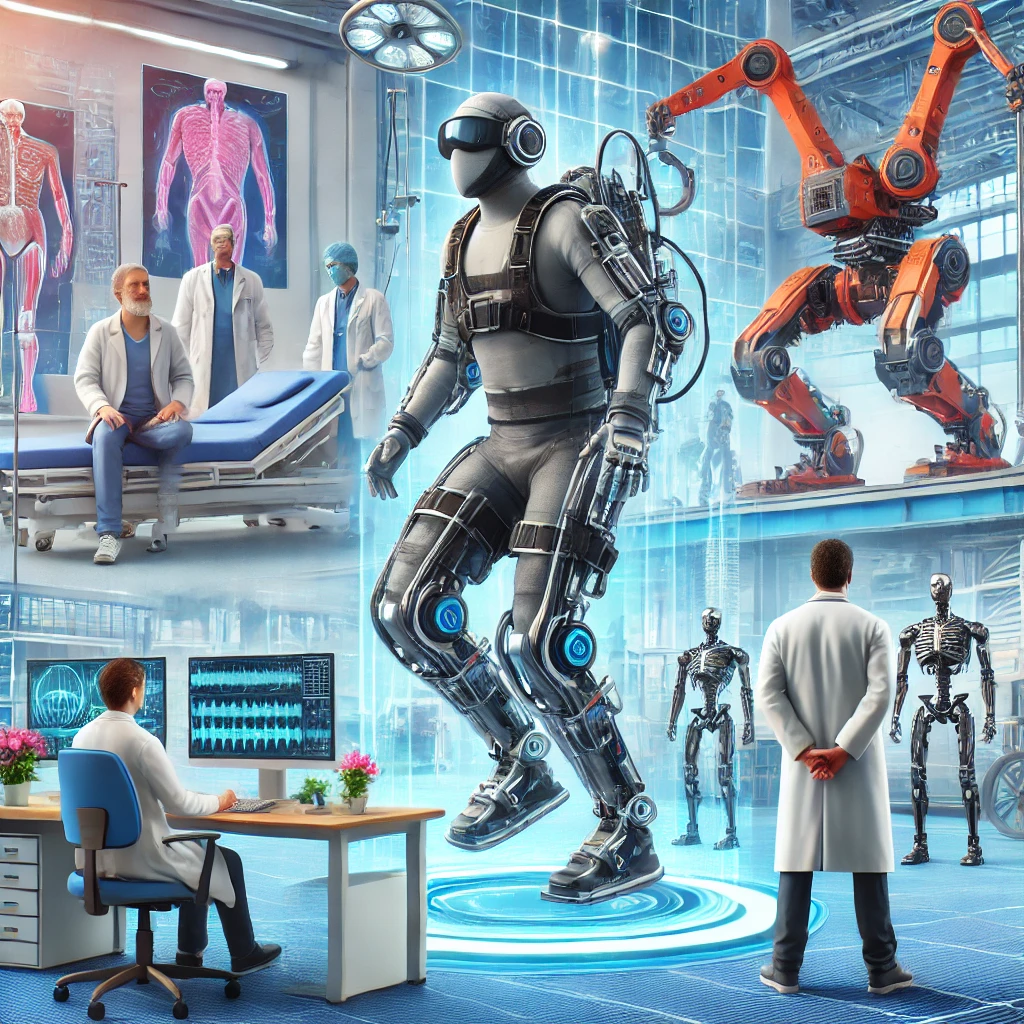Introduction
The fusion of robotics and human capability has led to one of the most exciting advancements in technology—wearable robotics and exoskeletons. Designed to enhance strength, mobility, and endurance, these devices are reshaping industries, from healthcare to manufacturing and military applications. Whether aiding rehabilitation in hospitals or preventing workplace injuries, wearable robotics are proving to be game-changers.
This article explores the evolution, real-world applications, challenges, and future of wearable robotics and exoskeletons, highlighting how they are revolutionizing human movement and endurance.
The Evolution of Wearable Robotics
Wearable robotics have their roots in early mechanical assistive devices designed to help individuals with mobility impairments. Over the years, technological advancements have transformed these rudimentary designs into AI-powered exoskeletons capable of responding dynamically to user movement. Key developments include:
- 1960s: The first powered exoskeleton, the Hardiman, was developed by General Electric and the U.S. Army, though it was too bulky for practical use.
- 1980s-2000s: Lighter and more adaptable prototypes emerged, focusing on rehabilitation and strength augmentation.
- Present: AI-driven, lightweight, and highly efficient wearable robotics catering to multiple industries.
Applications of Wearable Robotics & Exoskeletons
1. Healthcare & Rehabilitation
Wearable exoskeletons are redefining mobility for individuals with physical disabilities. These robotic devices assist in rehabilitation, offering improved muscle function, posture correction, and even walking support. Key applications include:
- Stroke Recovery: Exoskeletons help stroke patients regain mobility by retraining their muscles and nervous systems.
- Spinal Cord Injury (SCI) Assistance: Devices like Ekso Bionics’ EksoNR and ReWalk Robotics’ exoskeleton allow paraplegics to stand and walk.
- Elderly Mobility Support: AI-powered exoskeletons provide additional strength and balance assistance for aging individuals.
2. Industrial & Workplace Applications
In industries that involve heavy lifting and repetitive tasks, exoskeletons play a crucial role in preventing musculoskeletal injuries. Companies are adopting these wearable systems to enhance worker safety and efficiency. Examples include:
- Automotive & Manufacturing: Companies like Ford and Hyundai use exoskeletons to reduce strain on factory workers.
- Construction & Logistics: Wearable suits such as SuitX’s shoulder-supporting exoskeleton reduce workplace injuries by minimizing physical stress.
- Warehouse Operations: Robots integrated with AI help workers lift heavy loads without excessive fatigue.
3. Military & Defense
The defense sector is leveraging wearable robotics to enhance soldiers’ endurance, strength, and agility in combat scenarios. Powered exoskeletons offer increased mobility, reduced fatigue, and enhanced carrying capacity for soldiers. Notable military projects include:
- Lockheed Martin’s ONYX Exoskeleton: Reduces knee and leg strain while carrying heavy equipment.
- Sarcos Robotics’ Guardian XO: A full-body industrial exoskeleton that can lift up to 200 pounds with minimal effort.
4. Sports & Athletics
Athletes and trainers are now using wearable robotics to enhance performance and prevent injuries. Exoskeletons can assist in muscle recovery, injury rehabilitation, and strength training.
5. Everyday Consumer Applications
Wearable robotics are slowly entering daily life, with assistive devices for personal mobility. Startups and tech giants are developing robotic wearables to help individuals with disabilities lead independent lives.
Challenges & Limitations of Wearable Robotics
Despite the rapid advancements, wearable robotics still face several challenges:
- Cost & Affordability: High production costs make exoskeletons inaccessible to many individuals and small businesses.
- Battery Life & Power Efficiency: The energy consumption of these devices limits long-term usage.
- Weight & Comfort: Bulky designs may hinder natural movement, making prolonged use uncomfortable.
- Regulatory & Ethical Issues: Medical and workplace approvals are required for mass adoption, slowing innovation.
The Future of Wearable Robotics
The future of wearable robotics is promising, with advancements in artificial intelligence (AI), machine learning (ML), and biomechanics leading the way. Key trends include:
- Lighter, More Efficient Designs: Advances in materials science will create lighter and more flexible exoskeletons.
- AI-Integrated Smart Exoskeletons: Machine learning will allow wearable robotics to adapt dynamically to users’ movements.
- Wider Accessibility & Affordability: Increased production and competition will make wearable robotics more accessible to the general public.
- Brain-Computer Interfaces (BCI): Future exoskeletons could be controlled through neural signals, allowing a seamless connection between mind and machine.
Conclusion
Wearable robotics and exoskeletons are not just futuristic concepts—they are actively transforming healthcare, industry, military, and daily life. From helping paralyzed individuals walk again to preventing workplace injuries, these robotic innovations are paving the way for a more empowered, safe, and efficient human experience.
As technology continues to evolve, wearable robotics will become more lightweight, affordable, and AI-driven, making them an integral part of modern society. Whether for enhancing mobility or revolutionizing industries, the future of wearable robotics is one of limitless possibilities.
References:
- Ekso Bionics – https://www.eksobionics.com/
- ReWalk Robotics – https://rewalk.com/
- Lockheed Martin ONYX – https://www.lockheedmartin.com/
- Sarcos Robotics Guardian XO – https://www.sarcos.com/
- Hyundai’s Wearable Robotics – https://www.hyundai.com/
- Ford’s Exoskeleton Technology – https://corporate.ford.com/
- SuitX Shoulder-Support Exoskeleton – https://suitx.com/











+ There are no comments
Add yours